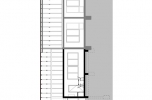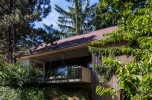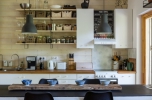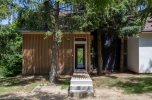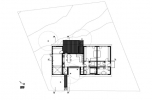Rational Common Sense Logic of Construction
Dwelling house, Piliscsaba
Architect: József Őrfi
Text: Tamás Kiss
Photos: Tamás Bujnovszky
The facade of the detached family house immediately shows that the building is a result of a later extension. Built after the turn of the millennia, it is a twin-design studio with two windows, which bravely takes on its original design, next to which there is now a smaller new building. The old brick-wall building has a facade clad in whitish plaster, whilst the new light-weight construction features vertical timber slabs positioned with some gap in-between. Where the two houses meet, the plane of the facade is retraced with some metres of width, and the colour of its surface turns into black. It already shows on the facade that the architecture fosters gentle relations with nature: the receding plane does not only counteract the longitudinal mass of the building, but also is the place where the structure obviously offers room for the vegetation, and respectfully steps back in order to host it. On the deck one can spot the analogy of vernacular dwelling houses, which is a reinterpreted variation of the formerly roofed porch. However, the covered-open space here steps out of the silhouette of the house, and is identified by following the principles of modernism, functionality and economy. This house located in Piliscsaba is a high-standard example of how to construct nowadays a tasteful and economically built house which can be adjusted to harmonize with its natural environment.

